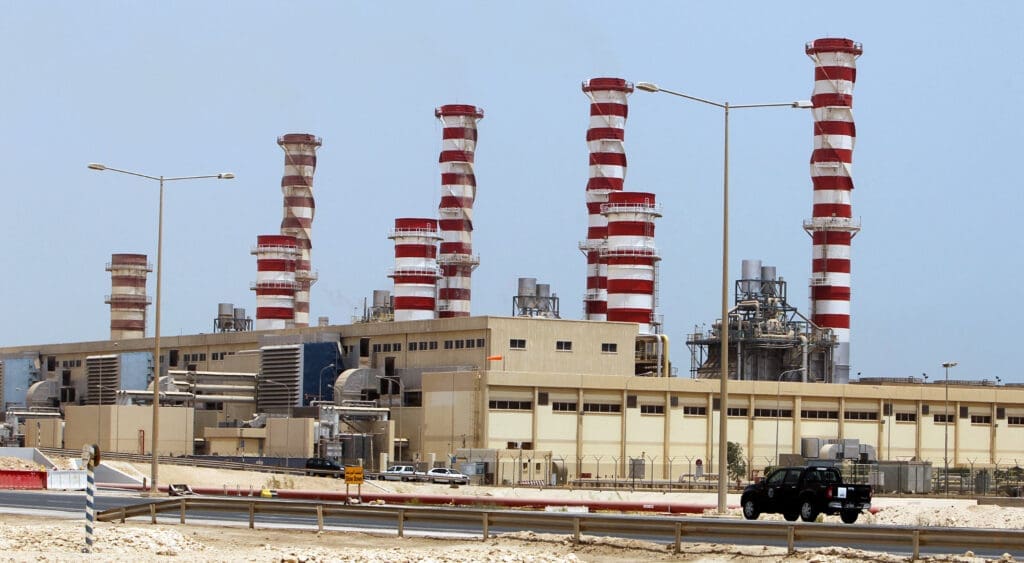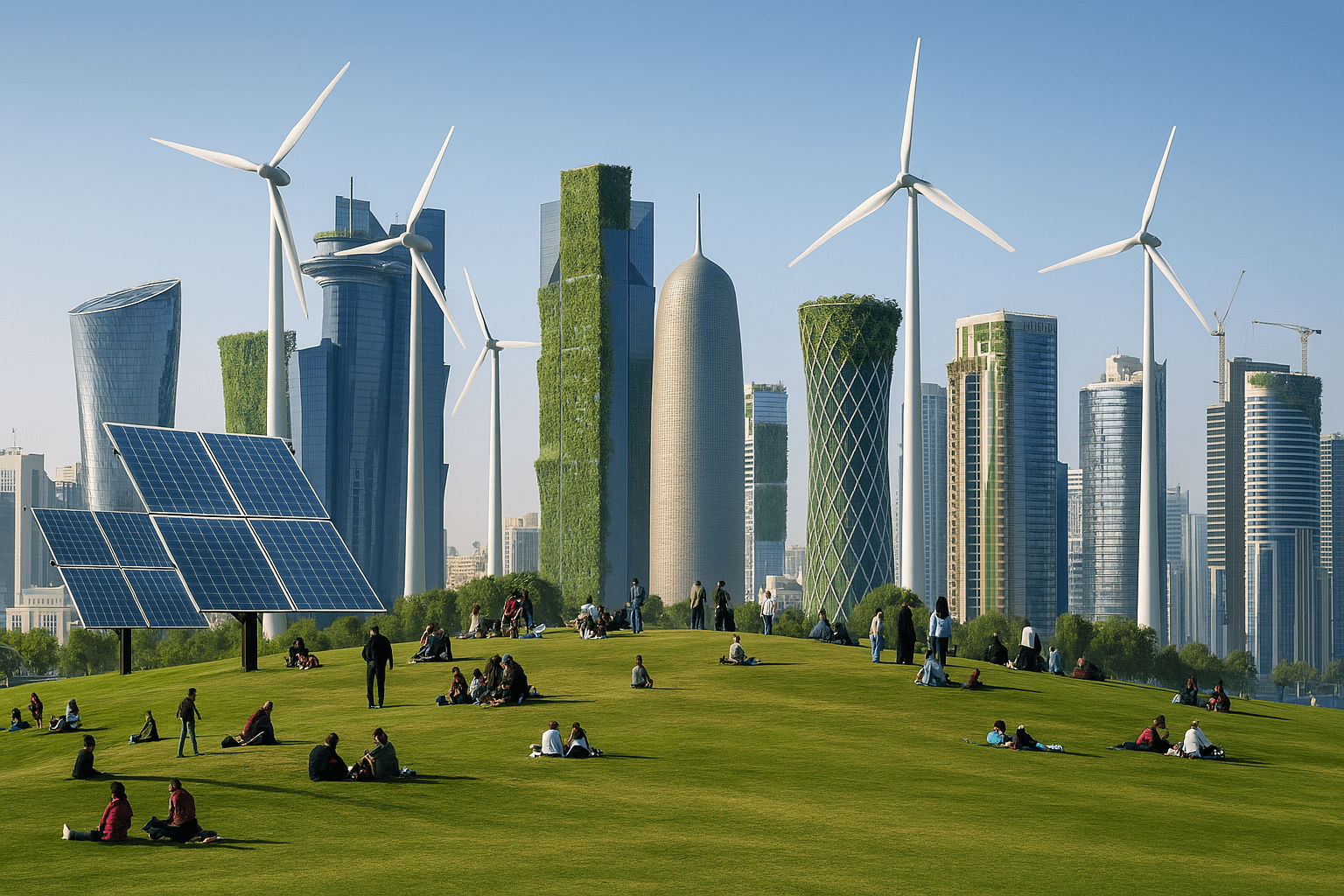
Carbon Markets as a Strategic Pathway to Carbon Reduction in Qatar
March 2025
Introduction
Qatar, with a population of approximately three million people, has a carbon-intensive economy, with annual greenhouse gas emissions of around 120 million metric tons of CO₂ equivalent (MtCO2e) in 2021.1 According to the production-based calculations of the UN’s climate agency UNFCCC, Qatar has some of the highest per-capita emissions worldwide, although its small population means this amounts to a negligible share of global emissions of around 0.3% in 2023.2 That being said, the energy sector accounts for over 96% of these emissions, including those related to the extraction, transformation, and refining of fossil fuels.3 This creates a conundrum for Qatar: how to maintain economic growth while addressing the carbon-intensive nature of the economy.
As the global economy moves towards decarbonization, major importers of Qatari energy, including the European Union, South Korea, China, and Japan, are implementing or developing carbon pricing mechanisms such as the Emissions Trading Systems (ETS)4 and the European Union’s Carbon Border Adjustment Mechanisms (CBAM).5 Failure to align with these frameworks may affect Qatar’s energy exports, including of liquefied natural gas (LNG) and petroleum products, which may be liable to certain carbon tariffs. This paper explores the potential for carbon markets in Qatar, and suggests a roadmap for integrating carbon trading mechanisms to help Doha meet its emissions reduction targets.
Global Trends in Carbon Markets
Carbon markets have emerged as a tool for reducing emissions by assigning a price to greenhouse gas (GHG) emissions, mainly targeting emission-intensive and hard-to-abate sectors. Putting a price on carbon incentivizes profit-driven enterprises to reduce emissions in order to remain competitive.
In 2023, the EU’s compliance carbon market6 (EU ETS) alone accounted for 38% of the bloc’s purchases of carbon credits, generating $47 billion in revenue.7 Carbon pricing initiatives now cover 18% of total GHG emissions globally, with carbon prices ranging from $5 to $120 per tonne.8
Over the past decade, carbon markets have expanded rapidly, with 36 fully operational ETSs worldwide as of 2024, covering some 18% of global GHG emissions. These markets generated over $74 billion in revenues in 2023.9
Recently, more sectors and regions have been integrated into ETSs, extending the global reach of carbon markets. Tightening emissions caps have led to upward pressure on carbon prices, reaching record highs of €100 per tonne on the European Union (EU) ETS in early 2023, although this later stabilized. Increasing numbers of companies are making net-zero pledges, driving demand for carbon allowances and offsets. Voluntary carbon markets10 are growing in importance, especially for companies unable to fully decarbonize in the short term.
Qatar’s carbon emissions are predominantly from the energy sector, particularly LNG production, oil refining, and natural gas flaring. In 2023, over 73.7% of Qatar’s emissions were from CO₂, while methane (CH₄), a by-product of natural gas extraction, accounted for 25.1%. The energy sector is responsible for 116 MtCO2e annually, to which methane leakages during natural gas extraction contribute significantly.11
Qatar’s existing climate commitments, as outlined in its Nationally Determined Contributions (NDCs) under the Paris Agreement, aim to reduce GHG emissions by 25% by 2030 relative to a baseline scenario.12 However, Qatar has no comprehensive carbon pricing mechanism in place to drive emissions reductions across industries.
Qatar’s commitment to reducing emissions by 25% is slightly higher than the Gulf Cooperation Council (GCC) average pledged reduction target of around 21.6%.13 Qatar’s NDC ambition is significant, but will require an elaborate roadmap if it is to be turned into reality.
The trends of expanding carbon market coverage, increasing carbon prices, and the growing importance of carbon credits and offsets may have direct implications for Qatar and the GCC. As major energy exporters, these nations face mounting external pressure to align with stricter international climate measures or risk losing market access and competitiveness. Increasing carbon prices and stringent emissions caps abroad could increase the cost of doing business, potentially forcing Gulf industries to improve production efficiency and adopt cleaner technologies.
Challenges in Establishing Carbon Markets in Qatar
Qatar’s initial emissions reduction efforts, like those of other GCC countries, rely mainly on voluntary offsets, with programs such as the Global Carbon Council (GCC) and Qatar Airway’s offset program. The growing voluntary carbon market allows Qatar and Gulf countries to diversify their economies, develop high-quality offset projects, and leverage their energy expertise to meet rising global demand for credible emission reductions.14
However, the global voluntary carbon market was valued at $723 million in 2023,15 far smaller than compliance markets, which generated $47 billion in the EU alone.16 Inconsistencies in verification methodologies can cause unwanted consequences, as is evident in the 2022 Qatar World Cup carbon offset program.17 A compliance market would offer Qatar more predictable revenue streams and stronger regulatory control, with clear rules and government oversight.18 Some ETSs accept certain types of voluntary carbon offsets. As international carbon policies tighten and key export markets introduce new standards, voluntary markets, complementary to compliance markets, would give polluters in Qatar more of an incentive to further reduce carbon emissions.
As noted above, Qatar has among the highest per-capita emissions globally, although its total emissions remain relatively low due to its small population. Nevertheless, there has been notable progress in addressing climate concerns. For example, the Global Carbon Council, based in Doha, is working to list its carbon credits with exchanges across the MENA region. Qatar Airways’ carbon offset program provides corporate customers with a mechanism to reduce their annual emissions. Additionally, the Ministry of Environment and Climate Change is developing a regulatory framework for carbon exchanges in Qatar. While specific details have not been revealed, the effort indicates Doha’s commitment to advancing sustainable practices.
Establishing a carbon pricing mechanism—whether in the form of an ETS or a carbon tax—will require comprehensive legislation that is aligned with the country’s economic goals. Robust emissions monitoring, reporting, and verification (MRV) systems are essential to ensure transparency and accountability. Qatar’s infrastructure and its institutional capacity to implement a carbon market are still in their early stages. Building market readiness will require investment in data management systems, skilled human capital, and institutional capacity to manage emissions trading. Coordination between the public and private sectors is critical for successful implementation.
The high share of GDP represented by the energy sector, downstream industries and energy-intensive chemical industries means that introducing carbon pricing could impose higher operational costs. On the other hand, such dominance implies a need for more substantial incentives to accelerate emissions cuts in the sector. A phased implementation, with transitional support, will be crucial to avoid economic shocks.
Qatar’s key export markets in Asia and Europe are committed to using carbon markets as an emissions reduction mechanism, developing and managing ETSs, and constantly innovating to create new mechanisms such as CBAM. Considering Qatar’s carbon-intensive exports to these regions, a lack of preparedness could mean that Qatar loses significant market share in the future.
In response to geopolitical developments in Ukraine and Russia in 2022, the EU accelerated its energy transition, revising the Green Deal (2019) and Fit for 55 (2021) targets, and diversifying its sources of natural gas. The May 2022 REPowerEU plan sets out how the bloc aims to end Russian gas imports by 2027 through enhanced energy efficiency, increased supply diversification—focusing on LNG—and an accelerated shift to renewables. Under this plan, the EU anticipates importing more LNG (+50 billion cubic meters) and additional pipeline gas, supported by a €10 billion investment in LNG infrastructure.
The EU External Energy Strategy, a component of REPowerEU, also outlines new international partnerships for additional gas and hydrogen supplies, engaging several countries—including Qatar.19 However, the EU’s CBAM may adversely affect Qatar’s LNG and petrochemical exports to the EU. In October 2023, the EU began the initial phase of its CBAM, requiring importers to disclose the CO₂ emissions associated with certain goods, including steel and cement entering the bloc. This policy aims to protect domestic industries, which are already taking steps towards reducing their emissions, from competition by foreign producers with looser environmental standards. By 2026, the mechanism is slated to impose a carbon tariff on imports equivalent to the costs faced by EU manufacturers, ensuring a level playing field while driving global efforts to produce cleaner, less carbon-intensive products.
These challenges require some urgency in developing new systems to accelerate carbon reduction. Evolving climate policies and carbon border mechanisms introduced by the EU and other regions underscore the importance of timely and strategic action.
Strategic Recommendations for Qatar
Qatar could accelerate efforts towards carbon reductions by establishing a dedicated government agency responsible for developing and overseeing carbon markets, including emissions trading systems (ETS) and carbon credits. This body would handle rulemaking for the carbon credit and ETS markets, organize the piloting and official operation of a carbon trading floor, manage allowance allocation, exchange, and surrender, and monitor the national greenhouse gas (GHG) inventory. By establishing a dedicated authority, Qatar could ensure proper oversight of its ETS and tap into a market that could generate revenues similar to other ETS regions, where auction proceeds from allowances have contributed over $74 billion globally.20
To ensure that Qatar remains informed about cutting-edge developments in the global carbon market, it would benefit by joining the International Carbon Action Partnership (ICAP) as an observer. ICAP, founded in 2007, brings together policymakers from governments operating or preparing to implement ETSs. Its 34 members and eight observers offer a platform to share practical experiences and knowledge.21 Qatar’s participation in ICAP would allow for early adoption of carbon market technologies and for Qatar to become a regional opinion leader in the Persian Gulf.
Qatar may also consider launching a domestic pilot ETS, initially focusing only on the energy sector, which is responsible for most of the country’s GHG emissions. Given Qatar’s high emissions from the production and refining of fossil fuels, an ETS with free allocations and a gradually declining cap would be a good starting point. This would allow industries to adjust gradually, encouraging emissions reductions without immediate financial strain. Over time, the system could expand to include other sectors. An ETS in the energy sector with a 2-3% annual declining cap could result in emissions reductions of approximately 3-4 MtCO2e annually in the early phases, eventually contributing to the pledged 25–30 MtCO2e reductions in under a decade.
The emergence of the EU’s CBAM highlights the importance of being prepared for novel carbon pricing mechanisms. If CBAM-like mechanisms are implemented in the Asia-Pacific region, Qatar’s exports could face carbon tariffs, impacting key sectors like LNG, which generated over $42.5 billion in net profits in 2022 for QatarEnergy, the state-owned oil and gas company.22 A proactive approach, including early adoption of compliance carbon markets and collaboration with international partners, would help Qatar maintain its export competitiveness as these mechanisms take hold globally.
Conclusion
Carbon markets offer Qatar a strategic opportunity to reduce GHG emissions, diversify its economy, and maintain international competitiveness. By establishing a domestic ETS, linking with global markets, and channeling the generated revenue into developing carbon-sequestering projects, Qatar can position itself as a regional leader in the transition to a low-carbon economy. Considering the global momentum around carbon pricing, Qatar would benefit from undertaking rapid, strategic measures to safeguard its long-term economic growth and environmental responsibility in a world increasingly shifting away from carbon-intensive practices.



